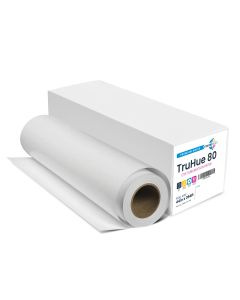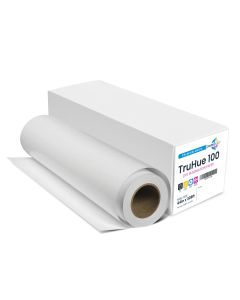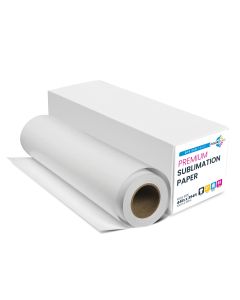-
 Jetcol® HTR1000 Sublimation Paper Roll - 66 GSM - 126" x 2625' - OVERSTOCKSpecial Price $870.00 Regular Price $1,841.00
Jetcol® HTR1000 Sublimation Paper Roll - 66 GSM - 126" x 2625' - OVERSTOCKSpecial Price $870.00 Regular Price $1,841.00 -
 Jetcol® HTR1000 Sublimation Paper Roll - 66 GSM - 126" x 820' - OVERSTOCKSpecial Price $350.00 Regular Price $528.00
Jetcol® HTR1000 Sublimation Paper Roll - 66 GSM - 126" x 820' - OVERSTOCKSpecial Price $350.00 Regular Price $528.00 -
 OVERSTOCK - Jetcol® HTR1000 Sublimation Paper Roll - 66 GSM - 75"x607'Special Price $145.00 Regular Price $237.95
OVERSTOCK - Jetcol® HTR1000 Sublimation Paper Roll - 66 GSM - 75"x607'Special Price $145.00 Regular Price $237.95
- In-Stock Same-Day Shipping by 5PM cst
- Free Shipping +$199
- Need Competitive Bulk Pricing?
Sublimation Paper
Having the Right Sublimation Paper Can Make a World of a Difference – Stock Up on Premium Quality Dye Sublimation Transfer Paper
Worrying about whether or not your sublimation transfer paper is going to produce the best results should be the last thing on your mind. With our extensive selection of easy-to-use, premium sublimation paper, you can feel confident that you aren’t wasting your time running test prints or fixing misprints, which will make it simple to get back to doing what you love – creating customized merchandise and improving your growing business. Whether you’re looking to decorate apparel, accessories, hard surfaces, or all of the above, we’ve got access to the right vendors and supplies to keep your sublimation business thriving. Because we know that not every company’s budget is the same, we have put together a selection of sublimation transfer papers at wholesale prices that afford decorators of all experience levels the ability to customize a variety of products with ease. We stand behind every product we offer, and we have a technical support team of experts to back up every type of sublimation paper we carry. Let us help you select the best dye sublimation transfer paper to fit your production and your budget needs, so you can get your orders completed correctly the first time.
Benefits of Using High Quality Sublimation Paper:Using an exceptional dye sublimation paper is essential to transferring vibrant images and keeping the precise detail and vibrancy of the original design intact. Premium sublimation paper will ensure that your transfers are bright, crisp and true-to-color, whether the products are for promotional use or retail sales.
How Do You Use Sublimation Paper?This type of paper is no ordinary printing product – in fact, sublimation paper is unique in that it allows the transfer image to actually become a part of the item. Products that can be used for sublimation include T-shirts, coasters, keychains, mugs, socks, puzzles, photo frames, and even mouse pads. They can be printed using images of logos, name brands, catchphrases, and various other detailed designs for retail, marketing and promotional use. During the sublimation process, special transparent sublimation inks are first printed onto the sublimation transfer paper – once the design has been printed, the paper is then fixed to the substrate and the design is pressed onto its surface using a heat press. When the correct temperature is achieved, the ink turns into a gas and the pores of the substrate open up. The gas seeps into the pores, and the pores enclose around the ink after the paper is removed and the item has cooled. This process ensures that the design from the sublimation paper has transferred completely to your substrate and your final print withstands any practical wear and tear.
The Difference Between Heat Transfer Paper & Sublimation Paper:There is a stark difference in the results of using heat transfer paper and sublimation paper. The first two steps of these processes are essentially the same. However, heat transfer paper uses heat to actually transfer a layer of the intended image on top of your substrate. In contrast, sublimation paper leaves no additional layer on top of the substrate. It actually becomes part of the substrate! The sublimation process uses heat to change the physical state of the sublimation ink on the paper, causing it to go from a solid directly to a gas. This essentially means bypassing the liquid phase.
This type of paper is no ordinary printing product – in fact, sublimation paper is unique in that it allows the transfer image to actually become a part of the item. Products that can be used for sublimation include T-shirts, coasters, keychains, mugs, socks, puzzles, photo frames, and even mouse pads. They can be printed using images of logos, name brands, catchphrases, and various other detailed designs for retail, marketing and promotional use. During the sublimation process, special transparent sublimation inks are first printed onto the sublimation transfer paper – once the design has been printed, the paper is then fixed to the substrate and the design is pressed onto its surface using a heat press. When the correct temperature is achieved, the ink turns into a gas and the pores of the substrate open up. The gas seeps into the pores, and the pores enclose around the ink after the paper is removed and the item has cooled. This process ensures that the design from the sublimation paper has transferred completely to your substrate and your final print withstands any practical wear and tear.












